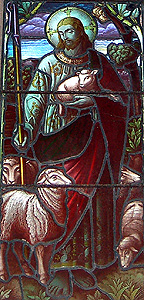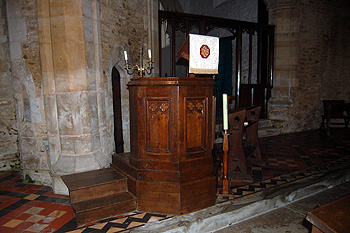List of Thurleigh Vicars

Christ the Good Shepherd from the south aisle east window September 2011
Advowson
Volume III of The Victoria County History for Bedfordshire was published in 1912. It noted that the first mention of the advowson of Thurleigh church is the end of the 12th century, when it was acquired by Canons Ashby Priory in Northamptonshire, which had been founded by Stephen de la Leye in the reign of Henry II (1154-1189). In 1227 it was noted that the prior secured the advowson by a royal writ against Nicholas de la Leye. The priory still held the advowson when it was dissolved by Henry VIII (1509-1547) in 1537.
In 1566 Oliver, Lord Saint John of Bletsoe received the advowson and the family held it until 1722. By 1731 it had been acquired by Sir Jeremiah Sambrook, from whom it descended to the Crawley family, who held it into the 20th century. In 1925 the advowson passed to the Bishop of Saint Albans [P97/2/1/1].
In 1949 Thurleigh began to be held in plurality with Bletsoe, the same clergyman serving both parishes [P97/2/1/2]. Milton Ernest and Pavenham were added to the plurality in 1953, though two years later Thurleigh came to be held solely with Milton Ernest [P97/2/1/2-3. This state of affairs was renewed in 1980 [P97/2/1/4]. Since 1998 the three parishes of Thurleigh, Milton Ernest and Pavenham have been held by the same incumbent. Each parish retains its own churchwardens and parish officers.

The pulpit September 2011
List of Vicars
- John Houghton, Archdeacon of Bedford: 1227;
- William de Northampton, subdeacon: 1245;
- Richard: 1268;
- Robert Buruil;
- William de Wyndelesore: subdeacon, on the resignation of Robert Buruil: 8th March 1271;
- Elias de Assh/Esseby, clerk in minor orders, on the presentation of William de Wynderhoue to Saint Peter's Rectory, Northampton: 16th June 1291;
- Paganus de Buckingham, on the death of Elias de Assheby: 23rd January 1319;
- John de Clifton, acolite, on the resignation of Paganus de Buckingham: 24th March 1320;
- John de Ebstow;
- Nicholas de Belen, chaplain, on the resignation of John de Ebstow: 26th April 1324;
- Robert de Kildesby, clerk: 14th November 1333;
- Robert de Dalderby, priest, on the resignation of Robert de Kildesby: 19th January 1334;
- Robert de Hynton, priest, on the death of Robert de Dalderby: 24th September 1334;
- Roger Sneuell of Renhold, clerk: 1st August 1349;
- John de Wodeford, on the death of Robert: 2nd November 1349;
- William Castell, priest, on the resignation of John de Wodeford who exchanged to Carleton Rectory: 9th September 1352;
- Henry Jurdon;
- John Mertton, priest, on the death of Henry Jurdon: 20th September 1382;
- Robert Lacy, also vicar of Walton [Buckinghamshire]: 10th March 1388;
- Milo Harrington;
- Thomas Poyntell;
- Nicholas Bateman, priest, on the death of Thomas Poyntell: 6th March 1469
- John Whirlett, priest, on the resignation of Nicholas Bateman: 3rd April 1471;
- John Laffenham , priest, on the resignation of John Whirlot: 18th March 1485;
- William Frankelyn, subdeacon, on the death of John Laffenham: 27th March 1501;
- Edward Phillip M.A., on the resignation of William Frankelyn: 12th September 1515;
- Hugh Massy, chaplain, on the resignation of Edward Philipe: 12th January 1533;
- Matthew Morlande (his will dated 20th September 1558, instructed that he be buried in the "quier of Thurleye Church", the will was proved at Southill on 1st November 1558): 15th September 1548;
- Miles Harrington, clerk, on the death of the last vicar: 17th December 1560;
- William Faircliff, clerk: 9th January 1565;
- William Forde: 28th March 1594;
- William Fourde, on the resignation of William Fourd, last incumbent, (he resigned 18th October 1607): 20th June 1598;
- William Forde: 4th April 1608;
- Thomas Lloyd alias Fludd , on the resignation of William Ford: 5th May 1616;
- Henry Spilwater (he died at Thurleigh in 1657, and was buried the following January): 8th February 1630;
- H.F. Brooks: May 1664;
- John Power, vicar (married Mary Winch of Clifton at Bedford, Saint John on 8th May 1705; he was buried 28th October 1705): 1665;
- Edward Bourne (married at Renhold on 17th October 1731 to Sarah Willis of Bedford, he was buried at Bedford Saint John on 5th August 1734): 10th June 1731;
- Thomas Beadles, clerk, on the death of Edward Bourn, he was formerly curate of Yelden and Shelton (he was buried on 1st December 1748): 5th September 1734;
- Robert La Roque, clerk, on the death of Thomas Beadles (he died in 1781): 25th January 1749;
- Oliver Saint John Cooper M.A., (New College, Oxford) (he died on 3rd May 1801 and is buried at Podington): 5th November 1784;
- Robert Moore, on the death of the previous incumbent (he died on 18th October 1834 and is buried at Biddenham): 10th September 1801;
- John Brereton, on the resignation of Robert Moore: 25th October 1833;
- Benjamin Trapp M.A., (Clare College, Cambridge), on the resignation of John Brereton: 26th January 1838;
- Robert Orr: November 1900;
- Charles Hemsley: April 1917
- Alfred William Garfield Edwards: March 1932;
- William George Branch: February 1950;
- James Alfred Prince Daniels: 1959;
- Harold Desmond Jones: 1964;
- Andrew Peter Mottram: 1984;
- Christopher Willett Gonin: 1992;
- Victoria E. Raymer: 1998;
- Nicola A. McIntosh: 2002;
- Elizabeth E. F. Inall: 2009

The font September 2001
Visitations
Volume 81 published by the Bedfordshire Historical Records Society (2002) is devoted to returns made during episcopal visitations to the county by the Bishop of Lincoln in the early 18th century, edited by former County Archivist Patricia Bell. It throws some interesting light on the non-residency of clergymen in their parish and the general state of the church in that place. At this date it was common for a rector or vicar to not live in the parish he nominally served, often because he had more than one, and so employed a curate to undertake their parochial duties for him. The returns for Thurleigh are as follows, showing that non-residency was not a problem in this parish:
- 1709: “Families 66 … None un-baptized, severall not Confirmed. Communicants not above 9. The rest seldom or never receive at all”.
- 1712: “The Vicar resides. None come to church Un-baptized. Severall not confirmed. Divine Service twice every Lord’s day, on Fasts and Festivalls, every Wednesday and Fryday in Lent … Communions 3 times a year. About 18 or 19 receive”.
- 1717: My Residence is constantly in the Vicarage house there is no Parsonage House. No Curate. I have baptizd only one who desired It about twelve years of Age. Service is duly performd twice every Lord’s Day and generally on Holy-days and on Wednesdays and Fridays in Lent … The Sacrament of the Lord’s Supper is administred on Christmass, Easter and Whitsonday. The Number of the Communicants may be reckoned double at Least to the Famelies [70], but ‘tis seldom known above sixteen or Eighteen Communicate therein. Notice is always given the Lord’s day before, in some of the Exhortations of the Church for that purpose, tho’ too many refuse to hear and observe them”.

Vexillum of Thurleigh Mothers Union September 2011
Ecclesiastical Census
On Sunday 30th March 1851 a census of all churches, chapels and preaching-houses of every denomination was undertaken in England and Wales. The local results were published by Bedfordshire Historical Records Society in 1975 as Volume 54, edited by D. W. Bushby. The return for Thurleigh church was made by the Vicar, Benjamin Trapp, who noted the following pieces of information:
- 104 free seats, 81 other seats, 90 seats for the Sunday School;
- General congregation 87 and Sunday scholars 81 in the morning;
- General congregation 153 and 84 Sunday scholars in the afternoon.